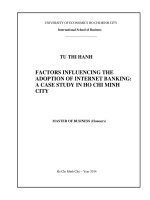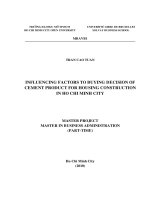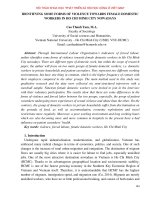The marketing strategy of tuong an vegetable oil factory in ho chi minh city
Bạn đang xem bản rút gọn của tài liệu. Xem và tải ngay bản đầy đủ của tài liệu tại đây (27.34 MB, 70 trang )
I.
J
1,
HO CHI MINH CITY UNIVERSITY
OF FOREIGN LANGUAGES
INFORMATION
TECHNOLOGY
SCHOOL OF FOREIGN LANGUAGES
11
GRADUATION PAPER
I
THE MARKETING STRA TEGY OF TUONG AN
VEGETABLE OIL FACTORY IN HO CHI MINH CITY
.1
Advisor: Mr Nguy~n Van ST,BA
Student: Cao Thi Ty Class: KA960z
HCMC, July, 2000
TV DQi HQc Huflit
1111111111111111111111111111
101000422
ACKNOWLEDGEMENTS
In completing this research paper, 1- the student of class KA960z - have
received invaluable encouragement, advide and help from my teachers, experts,
and friends,
First of all, I would like to thank my sponsor, Mr NguySn Van ST, for
recommending and providing materials and for giving me ideals and advice in
widening my knowledge of this issue and completing the research paper.
I am also grateful to President Huynh The' CUQc, who has enthusiastically
encouraged me, Dear Lucing Thi Ly and Vice- Le Thi Thu H~ng for their helpful
comments and advice.
I would like to take this opportunity to thank the following people and
organizations for their help and supports: TUONG AN Vegetable Oil Factory, The
National Company for Vegetable
Oils, Aromas, Cosmetics of Vietnam and
Statistical Office of Ho Chi Minh City.
Last but not least, I also wish to express my great appreciation to my
friends's supports and encouragement.
1
THE TABLE OF CONTENTS
ABSTRACT
Pages 1-2
INTRODUCTION
3
CHAPTERl: THE BASIC THEORIES
Pages 4-29
1. APPEARANCE AND DEVELOPMENT OF MARKETING
4
2. Role, Purpose and Function of Marketing In Society
6
2.1. Marketing Concepts
6
2.2. Role, Purpose and Function of Marketing
8
2.2.1. The Economic Role of Marketing in Society
9
2.2.2. The Economic Purpose of Marketing in Society
10
2.2.3. The Social Role of Marketing in Society
11
2.2.4. The Social Purpose of Marketing in Society
11
3. STRATEGIC MARKETING PLANNING PROCESS
12
3.1. Assess Current Performance
13
3.1.1. The Strategic Business Unit (SBU)
13
3.1.2. Business Portfolio Analysis
14
3.2. Establishing Specific Objectives
16
3.2.1. Monitor The Environment
16
3.2.2. Recognize The capabilities, Resource and Limitations
17
3.2.3. Understand The Opportunities and Risk
17
3.3. Develop The Marketing Strategy
18
3.3.1. Positioning
18
3.3.2. Growth Approaches
18
3.3.3. Marketing Approaches
19
3.4. Develop The Marketing Program
19
3.4.1. Select The Target Market
20
3.4.2. Develop Marketing Mix
20
3.4.3. Control The Marketing Plan
21
4. BASIC CONTENTS OF MARKETING STRATEGY
21
4.1. Product Strategy
21
4.2. Price Strategy
22
4.3. Distribution Strategy
25
4.4. Promotion Strategy
27
5. MARKET SEGMENTATION
28
5.1. Concepts
28
5.2. Market Segment Methods
28
29
5.3. Market Segment Strategy
29
5.3.1. Segmentation and Undifferentiated Marketing
29
5.3.2. Segmentation and Differentiated Marketing
29
5.3.3. Segmentation and Concentrate Marketing
CHNrER 2: ANALYSING MACRO ENVIRONMENT OF ENTERPRISE
AND VIETNAMESE VEGETABLE OIL MARKET
Pages 30-39
A. ANALYSING MACRO ENVIRONMENT OF ENTERPRISE
30
1. POPULATION
30
1.1. Age Structure
30
1.2. Situation of Accommodation Moving
30
1.3. Education Situation
31
2. ECONOMY ENVIRONMENT
31
2.1. Income of Population
31
2.2. Prices of Goods
31
2.3. Saving in Population
32
2.4. Structure of Expenditure per person in 1998
32
3. NATURAL ENVIRONMENT
33
4. TECHNOLOGY ENVIRONMENT
33
5. LAWS, POLITICS ENVIRONMENT
33
B. VIETNAMESE VEGETABLE OIL MARKET
34
1. PRESENT CONDITION
34
2. MARKET FORCAST
36
3. THE DEVELOPMENT OF VIETANMESE VEGETABLE OIL SECTOR
37
4. CHOLESTEROL AND THE POPULATION OF USE VEGETABLE OIL
38
5. THE ROLE OF TUONG AN FACTORY IN THE MARKET
39
CHAPTER 3: ANALYSING MARKET OPPORTUNITY AND THE
CONPETITION STRATEGIES OF TUONG AN
pages 40-58
1. Overview of TUONG AN Activities
1.1. Appearance and Development
1.2. Analyzing TUONG AN factory's position
1.2.1. Finance
1.2.2. Production
2. ANALYZING COMPETITORS
2.1. Neptune
2.2. Sailing Boat
2.3. Nakydaco
2.4. Maverlla
2.5. Other competitors
3. THE COMPETITION STRATEGIES OF TUONG AN
3.1. Analyzing Advantages and Disadvantages of TUONG AN
3.2. Solutions to Perfect Marketing Strategy
3.2.1. Product Strategy and Raising Product Quality
3.2.2. Price Strategy
3.2.3. Distribution Strategy
3.2.4. Promotion Strategy
CONCLUSION
40
40
44
44
45
45
45
46
46
46
47
47
47
50
50
54
56
58
pages 62-64
1
ABSTRACT
With the open door policy Vietnam has renovated its economy and established
the socialist oriented market under the state control. The open door policy not only
helps our economy recover gradually after a long period of war but also makes
.
.
Vietnam become an attractive market. Because of the fact that marketing strategy
has an important role in the development of companies, therefore to survive in this
fiercely competitive market, enterprises should have suitable marketing strategies
for each stage of economy.
The research
aims at providing some data and information derived from
literature and practical activities of TUONG AN vegetable oil factory and analyzing
some remarkable factors that have been considered to have effects on the strategies
of this company. The first part of this study is a summary of relevant theories and
some opinions stated by some reliable marketing researchers
and lecturers. A
collection of information from books in English or Vietnamese
brings a further
understanding of the issue such as the origin of the marketing, its importance, its
social roles and purposes social as well as its economic aspects. The type of
marketing planning process and segmentation are also mentioned in this part of the
study. Besides that, I take into consideration the contents of the marketing strategy.
The second part discusses mainly about the macro environment of the factory, the
vegetable oil market of Vietnam and TUONG AN market opportunity analysis.
The third part presents the marketing strategy of TUONG AN factory and some
of its advantages and disadvantages.
c2Jrad/ialioH paper
The last part consists of the conclusion and some suggestions, opinions about the
policy of government for development of vegetable oil sector and for TUONG AN
factory.
2
3
cJ)raduation /JtJ/!er
INTRODUCTION
Nowadays, the survival of an enterprise depends not only on the organization
structure, finance situation and commercial activities, but also on the marketing
strategy of the enterprise. The fact that the vital challenge which makes present
enterprises cope with is how to establish and maintain enterprises in the rapid
changing of market environment and 'how to enter the common market are the big
problems of managers.
The aim of this research is to point out the importance of marketing in
business activities and find out the strategic marketing for TUONG AN vegetable
oil factory to enlarge its market share.
The focus of this research is on consumption goods in Ho Chi Minh City
market, to analyze the competitive strategy of TUONG AN vegetable oil factory.
The organizations of this research including the appearance,
development,
roles and functions of marketing planning process, market segmentations,
and
contents of marketing strategy are also described in this chapter. Chapter 2 shows
some factors such as the macro environment of the factory and the vegetable oil
market of Vietnam.
Then in chapter 3 there comes the analyzing market opportunity and the
competition strategies of TUONG AN. And the last part of this study is the
conclusion and some suggestions that may be worth being taken into consideration.
"c;9ratillalitJn paper
4
CHAPTER ONE: THE BASIC THEORIES
l.APPERANCE AND DEVELOPMENT OF MARKETING
When the goods production of human beings has developed to period which
manual work gradually replacing by machine, productivity has increased, products
have been made more many, at that moment enterprises focused on looking for
market to consumer and find all methods to stimulate consumption. Marketing with
itself meaning
"make market"
appeared
and contributed to solve the above
problem ... however, since Marketing appeared until now, it has undergone a process
of changing sides of worldwide economy- society- politics. Beside that, Marketing
also has a historical period of different development in nation over the world, has
different definitions and differs its application scope in production and others. For
that reason,
there
are traditional
Marketing,
modern
Marketing
and future
Marketing.
In I6S0,the "phenomenon" of Marketing appeared in Japan when Mitsui, an
expert recorded who his customers were, their ideas and attitudes towards each item
and the difference of their ideas in reforming of his business activities to suit for
their demands. Until 19th century (1809 - 1884) Lyres H and Me Lonmich whom
were the first person in Western to start systematic studying about Marketing? They
said "Marketing is a function of commercial companies, enterprise and a special
work of management to find solutions in order to attract customer with most quantity
and gaining maximum profit. They were appreciate
in discovering method of
market research and segmentation, structure and content of market, distribution
,&adttali{)n paper
5
strategy, promotion policy, sale strategy ... All their contributions set a basement to
form theory foundation of Marketing science.
Until the beginning of 20th century, mass economists perfected more about
Marketing theories and Marketing form (speeding up sale product, advertisement,
and construction of product consumption, price strategy, and customer research ...).
During this time, the foundation of marketing research established step by step in
England, German,
and Austria with scientific name of marketing,
marketing
advisory department. The first time which marketing term was used in 1920 at the
auditorium of Michigan university in United- States. To 191O,all the important
general university in United- States started to teach marketing subject. During near
haft of century, marketing was just taught in countries where used English language.
Marketing was popularized to Western Europe and Japan Until after World War II,
in 50s, 60s,. The first marketing subject of Europe was established in Graj (Austria)
in 1968. After one year, in Master (the city of Federal republic of German) in which
a marketing subject of Europe also appeared.
Nowadays, marketing has been propagated, rapidly applies and effects in
business, production in all America, Europe, Asia, Australia, and Africa countries.
At present marketing theory and application develop not only in business field but
also in other fields such as politics, diplomacy, army, training and training program,
union task.
With the open door policy, the socialist oriented market economy under the
state control has been established, marketing developed and applied effectively in
production, especially
garments ...
it succeed in cooking oil, rice, seafood, footwear and
6
c2JradliafitJfl paper
2.ROLE, PUPOSE AND FUNCTION OF MARKETING
2.1. Marketing Concepts
Before turning to the role and fuction of marketing we mention cursorily
about marketing concepts.
Peter Drucker a leading management thinker put marketing in this way: "The
aim of marketing is to make selling superfluous. The aim is to know and understand
the customer so well that the product and service fits him and sells itself".this does
not mean that selling and promotion are unimportant, but rather that they are part of
a larger "Marketing mix" a set of marketing tools that work together to affect the
marketplace.
According to Elizabeth,
Wiesechofer
Barners , Bod Mcdelland,
Richard Meyer, Hideyard
and Nike Worsam: "Marketing is concerned with identifying
satisfying customers and customer
'S
and
needs . Or with Philip Kotler and Amstrong
marketing is defined "Marketing is human activity directed at satisfying needs and
wants through exchange
marketing
processes. ". In addition,
speccific
trait of modern
that: "market is the most important position of reproduction process of
product. In the market, buyer has determining role. Demand is his aim of production
and meet the needs is the most vital factor of production ".
It is said that "Modern marketing concept affirms that the first requirement to
obtain business target is define the demand and wants of market and guarantee the
degree of satisfying need by more effective than the methods of competition"
(Philip Kotler).
The marketing concept has been stated in colorful ways, such as "Find a
need and fill it", "Make what you can sell instead of trying to sell what you can
make", "Have it your way "(Burger King) ;and "you are the boss "(United Arlines).
7
For that reason, there is a general definition of marketing "Marketing is
organizatio
'S
activities aims at sensing, serving, satisfying customer's needs and
wants.
Its aim is to ensure that the business is able to anticipate changes
needs and to gain and retain customers efficiently
and profitably.
in these
Although
marketing is concerned with satisfying these needs, its scope goes far beyond the
process of selling goods and services.
To reinforce, figure 1.1 summarizes the position of the core concept of
marketing.
Needs
/
--M-a-r-ke-t-s--I
Transactions
Exchange
Wants
Core marketing
concepts
I ..•
Demands
Products
-
Figure 2.1 The core concept of marketing
In another way, the marketing concept is frequently confused with the selling
concept. Figure 1.2 compares the two. The selling concept starts with the company's
cfJradtItJlion pt1/Jer
existing
8
products
and calls for heavy selling and promoting
sales. The marketing
target customers.
concept
starts with the needs
According to modern marketing
cosumers
want, and in this way satisfy consumers
integrates
all the activities
this marketing
concept
industrial goods companies,
satisfation.
more in comsumer
We also know that
goods companies
Ends
Profits and sales volume
Selling and promotion
a, The selling concept
Integrated 11arketing
Customers
than in
than in small ones.
11eans
Products
produce what
and make profits. The company
and in large companies
Focus
profitable
and wants of the company's
concept, companies
that will affect customer
is practiced
to achieve
Profits through customer
needs
~----'-----
[>
satisfaction
b. The marketing concept
Figure 2.2: The selling and marketing concepts contrasted
2.2.. Role, Purpose And Function Of Marketing
The more
time goes the more people
business, it is originated
Nowadays,
provides
marketing
information
turn,strategic
from the development
planning
plays
and either
realize
defines marketing's
of marketing
III
of society and economy.
an important
inputs
the role
to help
role
prepare
in strategic
planning.
the strategic
role in the organization.
plan.
It
In
Guided by the
dJradllali(Jn
paper
9
strategic plan, marketing works with other departments in the organization to help
achieve overall strategic objectives.
Function of marketing is all business activities, firstly focusing organization on
needs and wants of customers and through solutions to satisfy needs effectively to
get profits. Function of marketing consists of pre-production stage, in-production
stage and post-production stage.
It is able to summarize function of marketing as follows.
- Needs discover.
- Suitable product to market demand.
- Distribution and setting prices.
- Promotions.
- Human resourse management, production and finance.
Besides, the role and function of marketing are important not only in the
marketing activities and decisions within the individual business organization but in
society as well.
2.2.1. The Economic Role Of Marketing In Society
Both within an economy and between economies, people learn that they can
gain much by engaging in exchange, that is, trading goods and services for either
money or other goods and services. Ultimately, parties that exchange will acquire
better goods and services, these goods and services will often cost less if the party
try to make the items themselves. One of the benefits of exchange. First, when
people concentrate on the production
of a particular good. This is known as the
effect of specialization. The second factor producing economic benefits of exchange
is known as economies
of scale.The marketing process makes an important
WMtlation paper
10
contribution to briging about exchange between parties and thus helps bring about
specialisation
and economies of scale. The conception of goods pricing them,
promoting them and distributing them(recall these factors from the definition of
marketing ) directly relate to the process of exchange. In the absence of some
mechanism for exchanging goods that are produced,
neither the specialization nor
the economies of scale effects on exchange would be realized.
The basic issue to be understood here is that exchange serves an important
role in an economy by providing goods and services effectively and efficiently. The
demand for goods and services is postered by the collective Marketing efforts of
many organisations and the economy is stimulated and grows Marketing, then, plays
an integral role in an economy by facilitating exchange.
2.2.2. The Economic Purpose of Marketing in Society
In the broad perspective, economists point out that the overall economic
purpose of Marketing in society is to bring about satisfaction. This satisfaction is
refered to in economic terms as utility. The entire Marketing system works to create
four types of utility: form utility, time utility, place utility, and possession utility.
Form utility is created when a product (or service) is provided to a buyer in
form that is both useful and useable.
Time utility refers to the satisfaction gained from having a product available
at the time at which it is desired. Marketing decisions related to product storage and
inventory as well as to production scheduling combine to create time utility.
Place utility is the satisfaction customers receive when a product is located
where they want it.
Finally, possession utility relates
to what broad economIC purpose for
Marketing where consumers can acquire the satisfaction of product as quickly as
c2Jratillalion paper
11
possible. That is, the Marketing system works in such a way that consumers can "
possess" a product and begin to benefit with few hassles.
2.2.3. The Social Role of Marketing in Society
The social role served by Marketing has several dimensions. First, Marketing
activities can promote innovation. Innovation is an activity that not only provides
new and better products to satisfy customers and earn revenues for firms but also
benefits society as a whole. The second dimension of the social role of Marketing is
to produce a greater variety and choice of products and services. As more products
and services are made available, then individuals are more likely to find items
suited to their unique needs and desires.
Third, the process performs the function of information provision. The effect
is reduced search time associated with acquiring goods, which is turn reduces the
cost of exchange.
Reducing the cost of exchange
subsequently
increases the
satisfaction associated with the exchange.
Finally, some firms are accepting an environmemtal role in the production
and distribution of goods and services.
2.2.4. The social purpose of Marketing in society
The purpose of Marketing
in a society can be stated directly as the
responsibility to deliver a standard of living to society. Marketing encompasses
those activities that deliver to society that discoveries
of scientists and the
intentions of entreprenuers. No other social or business activity fulfils the need for
design, pricing, information provision(promotion) and physical delivery(distribution)
of the output of society. As such, Marketing performs an important social purpose.
cf7radtlafion paper
3.
12
STRATEGIC MARKETING PLANNING PROCESS
Companies that live by the Marketing concept realize that Marketing efforts
are more successful when they are carefully planned. Strategic Marketing planning
is a process of examining a company's market opportunities, allocating resources to
capitlize on those opportunities and predicting
market and financial performance
that is likely to occur. The results of strategic Marketing planning are documented in
the Marketing plan which summarizes the objectives states the situation analysis,
and outlines strategies and programs designed to help the organisation reach those
objectives.
As figure 1.3 shows strategic marketing planning is a four step process that
assesses current performance, establishes specific Marketing objectives, develops
Marketing strategies, and designs Marketing programs. Once the plans are in place,
the Marketing programs are implemented
and the results are monitored. If
everything works, the feedback mechanism provides the good news. On the other
hand, if the Marketing
program does not meet expectations,
feedback
help
marketers tune the process, strategic Marketing planning is a continuing process, not
a one-time event, and continuous monitoring and feedback is the best way to stay in
touch with dynamic market conditions.
c9ratitlalion
paper
13
Assess
current
performance
Establish
specific
objectives
~
Develop
Marketing
strategies
~
~
fl=
4i
IT
Design
Marketing
programs
ft
[ I
Provide
feedback
Monitor
results
Implement
programs
\==:J
Figure 1.3 The strategic marketing process
3.1. Assess Current Performance
A good strategic
assess the performance
Marketing
plan requires
of these products
that the company
and business.
periodically
To do so, the company
should be a ware of
Several
concepts,
starting
with the strategic
business
unit and portfolio
analysis.
3.1.1 The strategic business unit (SHU)
The strategic
business
unit (SBU) is the basic unit of the firm for strategic
planning purposes. An SBU might be the entire company, a division, a product line,
or even a single product as long as the unit can be considered
planning purposes. This generally
own access to resources,
a separate
entity for
means that it must have its own management,
its own competitors,
and its own customers.
its
Often when a
cfi;radttalion paper
14
firm's management begins strategic planning, it finds that the company must be
restructured to create meaningful strategic business units out of a hodgepodge of
divisions that compete with another.
3.1.2. Business Portfolio Analysis
Many companies
use a form of portfolio analysis,
which provides
a
framework for categorizing each of the company's SBUs. Categorizing the various
business effort help the company design, an individual strategy for each business
unit.
One of the most widely knows portfolio analysis schemes are the model
pioneered in the early 1970s by the Boston Consulting Group (BCG). BCe's
growth/share matrix looks at two variables: the market share held by an SBU and
the rate at which the market is growing (see figure 1.4).
High
Stars
Question Marks
Low
Cash cows
Dogs
High
Low
MARKET SHARE
Figure 1.4: The BeG growth! share matrix
The best SBUs are those in the most attractive markets and most consistent
with the business position- the strange- of the firms. The results of the evaluation
allow planners to position an SBU on a grid indicating whether that SBU is to
c2Jradtla!/(Jn
paper
15
receive investment for what purposes and how much. Entries in the three cells of
the upper left-hand corner of the model are destined to receive investment for the
purpose illustrated. Those on the lower left! upper right diagonal will be selectively
supported to maintain their position, and those in the lower right corner will be used
to generate cash flow or will divested.
To address the second problem, the market attractiveness/ business position
.1
model uses multiple criteria to evaluate markets. It summarizes how attractive a
given opportunity seems to be and you are ability to capitalize on that opportunity.
In doing so, this model presents a realistic characterization
of the decisions
marketers make. As you can see from figure 1..5 the attractiveness/
business
position model examines markets more thoroughly than the growth/share matrix.
U)
U)
~
Z
~
>
ã.....
High
Very Attractive
Attractive
Acceptable
Medium
Attractive
Acceptable
To be avoided
Low
Acceptable
To be avoided
To be avoided
Strong
Medium
Weak
f-<
U
ô
0:::
I::
ô
f-<
~
~
0:::
ô
BUSINESS POSITION
Figure 1.5: Market attractiveness/
Business position matrix
cf;raduation
paper
16
Like the growth/share
model is not a perfect
matrix, the market
tool for decision
attractiveness/
making.
business
Depending
on the factors
choose and the way in which you scale them, an SBU might look perfectly
in one model but unacceptable
position
you
attractive
in a second model. You should never base decisions
strictly on these (or any other) models. They should be used to help diagnose
your
current situation and to support your judgment -not to replace it.
3.2 Establishing Specific Objectives
Marketing
planning
is part of a hierarchy
of planning
the begins with your
overall strategic business plan. That plan grows out of your organizational
statement
mission, a
of the role your firm should play in the market and the way you want to
be perceived
by customers.
Once
the mission
statement
developed,
IS
objectives
that are specific and measurable.
marketing
planners
organization's
must monitor
capabilities
three
To develop
factors:
and resources,
marketers
need
to establish
good objectives,
the marketing
market,
environment,
and the risks and opportunities
the
in the
market.
3.2.1 Monitor The Environment
It is not denied
resources,
and
government
number
opportunity,
regulations
of companies
natural environment
in demographics
that any factor of the environment
objectives
and,
strategies.
can close down some markets
have attempted
by marketing
to capitalize
can affect enterprise's
For instance,
and open
on consumer
products that are environmentally
can also affect enterprise's
product promotion,
changing
up others
concern
.A
for the
friendly. Shifts
and price elements.
17
dJradtlafion paper
3.2.2 Recognize The Capabilities, Resource And Limitations.
A good strategic plan capitalizes on the company's
strengths and seek to
minimize the effects of its weaknesses, The thing a company does better than
everyone else in the market is called distinctive competencies, and they can be the
foundation for a successful marketing strategy,
In addition to building distinctive competencies,
company also needs to
consider the resources at its disposal. Even a brilliant marketing strategy is of little
value if the company does not have the time, money, organization skills required to
full it off,
3.2.3 Understand
The Opportunities
And Risks.
It is not enough to search out opportunities in the marketplace; the company
must also understand the risks that each opportunity presents, There are many types
of risks in marketing, On the other hand, company sometimes run the risk of being
so successful that you invites competition.
Marketers often combine several stages of examination in a technique called
SWOT analysis, from an acronym for strengths, weaknesses,
opportunities and
threats. Once they have analyzed both themselves and their competitors using
SWOT analysis, they have a good idea of what their strategic objectives should be and what their competitors'
objectives might be, Applying SWOT analysis to
company's competitors is part of a larger effort known as competitor intelligence,
which is a systematic process of understanding competitors and their influence on
company's markets.
Timing is an important element in marketing planning. The term strategic
window identifies a limited period of time during which the characteristics of a
market and the distinctive competencies of a firm fit together well, thus reducing
18
the risk. Strategy windows can open when customer needs evolve new technologies
in the marketing environment change. And windows can close for the same sorts of
reasons.
3.3 Develop The Marketing
Strategy
Designing the marketing strategy involves a realistic assessment of firm's
strengths and weaknesses
weighed against the opportunities and risks that firm
believes exist in the marketplace.
factors
into a program
Firm must somehow reconcile and fit these
that maximizes
the firm's
strengths,
minimizes
its
weaknesses, takes advantage of opportunities while avoiding pitfalls, and ultimately
delivers the desired results. There is three activities firm need to complete in order
to develop a marketing strategy.
3.3.1 Positioning
The process of achieving of desires spot in the mind of customers and
potential customer is called positioning. Obviously, only one product can hold the
top position in your mind. To begin with, not everybody will agree the positions in
your mind. In fact you can segment markets based on the various positions that
people perceive.
3.3.2 Growth Approaches
After a company has chosen a desired position in the market. Few firms want to
stagnate in the marketplace, so a basic element of marketing strategy is selecting
the growth approach that will best meet their objectives. When the company grows,
it can provide increasing
opportunities for employees,
owners, and stronger positions in its market.
3.3.3 Marketing
Approaches
increasing
income for
c9Jradttalion paper
19
Once Company has decided how it will pursue growth; it needs to define its
overall approach to marketing. Its choices are undifferentiated,
differentiated,
or
concentrated marketing.
Undifferentiated marketing
The simplest form is undifferentiated marketing, which company sell only
one product or product line and offer it to all customers in a single marketing mix.
Firms that are an undifferentiated marketing strategy are often aware that
there are distinct groups of users of their products. However, they try to cover the
whole spectrum as broadly as possible, relying on the product's versatility or lack of
competition for success. They often knowingly run the risk of their strategy
backfiring if a competitor creates products that is specialized toward one of the
groups in which they have an interest.
Differentiated marketing
These firms are still attempting to satisfy a large proposition .of the total
market, but instead of doing it with one product offered one way, they market a
wide variety of products designed to appeal to well defined subgroups of the whole.
Concentrated marketing
Many firms shoot for very narrow niche markets or segments of national
markets. The approach to use in these cases is concentrated
marketing, which
targets a single market segment with a single product or limited line of products.
Firms with limited resources can use it or in markets with specialized customer
segments.
3.4 Develop The Marketing Program
c9radllation paper
20
The final step of the process of strategic marketing planning is to develop the
program that will help the organization meet its objectives. This invoives two
general steps: selecting the target market and designing the marketing mix.
3.4.1 Select The Target Market
There are numerous techniques for selecting target markets. Here are some of
the more common ways companies identify potential targets.
•
"Gap analysis" can isolate segments that are not being served adequately be
existing supplies. With this technique, company methodically
scans market
segments to see whether there are unmet customer needs.
•
The success of a competitor can alert company to an opportunity.
•
Company's customers can bring opportunities to its attention. As its customers
grow and change, they may need new goods and services, which can open new
markets for company.
•
Other sources of information, including consultants, marketing research firms,
the new media, and government
agencies,
can bring opportunities
to its
attention.
When a company identify a potential target market, there are several test
company should apply before proceeding. First, the market must be big enough to
justify the effort needed to enter it. There must be a need within the market for a
product that you are capable of delivering. There should be potential for growth
within the market. Finally, the structure of demand has to give you a reasonable
chance of making a profit. .
3.4.2 Develop A Marketing Mix
If the analysis of a potential market is promising enough to make it a good
target, develop a marketing mix that will appeal to this market. Assemble to
c;9radllalion
paper
21
combination of product characteristics that closely match what the customers in the
target are looking for. Create a structure of prices that will make product purchase
feasible for market members. Puts together a distribution system that assures goods
is make
available
where
and when they are wanted.
Finally,
assemble
a
promotional mix of advertising and others tools that will communicate with the
members of the market benefits of what you have to offer.
3.4.3 Control The Marketing Plan
. Controlling the marketing plan involves three steps: (I)-measuring
of the implementation,
results
(2)-comparing results with objectives, and (3) deciding
whether the plan is meeting objectives. If there are major differences between the
desired results and those achieved, modifications to the plan may be necessary.
In conclusion, the marketing planning process begins at the corporate level with the
development of objectives. It then moves to develop procedures for accomplishing
these objectives. First, a company must define its mission. It then determines its
objectives,
assesses
its resources
and
evaluates
environmental
risks
and
opportunities. Guided by this information, the marketing department then formulates
a marketing strategy; implement the strategy through marketing plans, and gathers
feedback to monitor and adapt strategies when necessary.
4.
BASIC CONTENTS OF MARKETING STRATEGY
4.1 Product Strategy
Product strategy is an important part of marketing mix, and the most shape
tool in market competition. So, product strategy is an effective production method









